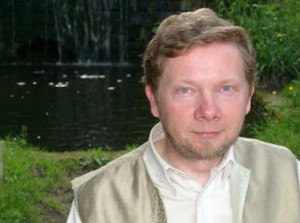by Eckhart Tolle: Most ancient religions and spiritual traditions share the common insight – that our “normal” state of mind is marred by a fundamental defect. However, out of this insight into the nature of the human condition  – we may call it the bad news – arises a second insight: the good news of the possibility of a radical transformation of human consciousness.
– we may call it the bad news – arises a second insight: the good news of the possibility of a radical transformation of human consciousness.
In Hindu teachings (and sometimes in Buddhism also), this transformation is called enlightenment. In the teachings of Jesus, it is salvation, and in Buddhism, it is the end of suffering. Liberation and awakening are other terms used to describe this transformation.
The greatest achievement of humanity is not its works of art, science, or technology, but the recognition of its own dysfunction, its own madness. In the distant past, this recognition already came to a few individuals. A man called Gautama Siddhartha, who lived 2,600 years ago in India, was perhaps the first who saw it with absolute clarity. Later the title Buddha was conferred upon him. Buddha means “the awakened one.” At abut the same time, another of humanity’s early awakened teachers emerged in China. His name was Lao Tzu. He left a record of his teaching in the form of one of the most profound spiritual books ever written, the Tao Te Ching.
To recognize one’s own insanity, is of course, the arising of sanity, the beginning of healing and transcendence. A new dimension of consciousness had begun to emerge on the planet, a first tentative flowering. Those rare individuals then spoke to their contemporaries. They spoke of sin, of suffering, of delusion. They said, “Look how you live. See what you are doing, the suffering you create.” They then pointed to the possibility of awakening from the collective nightmare of “normal” human existence. They showed the way.
The world was not yet ready for them, and yet they were a vital and necessary part of human awakening. Inevitably, they were mostly misunderstood by their contemporaries, as well as by subsequent generations. Their teachings, although both simple and powerful, became distorted and misinterpreted, in some cases even as they were recorded in writing by their disciples. Over the centuries, many things were added that had nothing to do with the original teachings, but were reflections of a fundamental misunderstanding. Some of the teachers were ridiculed, reviled, or killed; others came to be worshipped as gods. Teachings that pointed the way beyond the dysfunction o the human mind, the way out of the collective insanity, were distorted and became themselves part of the insanity.
And so religions, to a large extent, became divisive rather than unifying forces. Instead of bringing about an ending of violence and hatred through a realization of the fundamental oneness of all life, they brought more violence and hatred, more divisions between people as well as between different religions and even withing the same religion. They became ideologies, belief systems people could identify with and so use them to enhance their false sense of self. Through them, they could make themselves “right” and others “wrong” and thus define their identity through their enemies, the “others,” the “nonbelievers” or “wrong believers” who not infrequently they saw themselves justified in killing. Man made “God” in his own image. The eternal, the infinite, and unnameable was reduced to a mental idol that you had to believe in and worship as “my god” or “our god.”
And yet… and yet… in spite of all the insane deeds perpetrated in the name of religion, the Truth to which they point still shines at their core. It still shines, however dimly, through layers upon layers of distortion and misinterpretation. It is unlikely, however, that you will be able to perceive it there unless you have at least already had glimpse of that Truth within yourself. Throughout history, there have always been rare individuals who experienced a shift in consciousness and so realized within themselves that toward which all religions point. To describe that nonconceptual Truth, they then used the conceptual framework of their own religions.
Through some of those men and women, “schools” or movements developed within all major religions that represented not only a rediscovery, but in some cases an intensification of the light of the original teaching. This is how Gnosticism and mysticism came into existence in early and medieval Christianity, Sufism in the Islamic religion, Hasidism and Kabbala in Judaism, Advaita Vedanta in Hinduism, Zen and Dzogchen in Buddhism. Most of these schools were iconoclastic. They did away with layers upon layers of deadening conceptualization and mental belief structures, and for this reason most of them were viewed with suspicion and often hostility by the established religious hierarchies. Unlike mainstream religion, their teachings emphasized realization and inner transformation. It is through those esoteric schools or movements that the major religions regained the transformative power of the original teachings, although in most cases, only a small minority of people had access to them. Their numbers were never large enough to have any significant impact on the deep collective unconsciousness of the majority. Over time, some of those schools themselves became too rigidly formalized or conceptualized to remain effective.









































